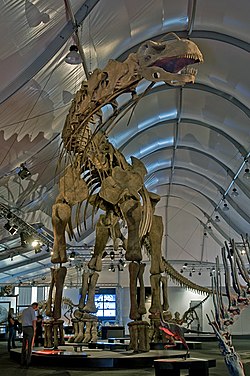Argentinosaurus
|
Argentinosaurus Temporal range: Late Cretaceous, 97–94 Ma |
|
|---|---|
 |
|
| Reconstructed skeleton, Naturmuseum Senckenberg | |
| Scientific classification | |
| Kingdom: | Animalia |
| Phylum: | Chordata |
| Class: | Reptilia |
| Clade: | Dinosauria |
| Order: | Saurischia |
| Suborder: | †Sauropodomorpha |
| Clade: | †Neosauropoda |
| Clade: | †Macronaria |
| Clade: | †Titanosauria |
| Family: | †Antarctosauridae |
| Genus: |
†Argentinosaurus Bonaparte & Coria, 1993 |
| Species: | †A. huinculensis |
| Binomial name | |
|
Argentinosaurus huinculensis Bonaparte & Coria, 1993 |
|
Argentinosaurus (meaning "Argentine lizard") is a genus of titanosaur sauropod dinosaur first discovered by Guillermo Heredia in Argentina. The generic name refers to the country in which it was discovered. The dinosaur lived on the then-island continent of South America somewhere between 94 and 97 million years ago, during the Late Cretaceous Period. It is among the largest known dinosaurs.
The first fossils identified as Argentinosaurus were found in 1987 by a rancher in Argentina, who mistook the leg for a giant piece of petrified wood. A gigantic vertebra, approximately the size of a man, was also found.
The type species of Argentinosaurus, A. huinculensis, was described and published in 1993 by the Argentine palaeontologists José F. Bonaparte and Rodolfo Coria. Its more specific time-frame within the Cretaceous is the late Cenomanian faunal stage, ~96 to 94 million years ago. The fossil discovery site is in the Huincul Formation of the Río Limay Subgroup in Neuquén Province, Argentina (the Huincul Formation was a member of the Río Limay Formation according to the naming of the time).
Not much of Argentinosaurus has been recovered. The holotype included only a series of vertebrae (six from the back, five partial vertebrae from the hip region), ribs of the right side of the hip region, a part of a rib from the flank, and the right fibula (lower leg bone). One of these vertebrae was 1.59 meters tall, and the fibula was about 1.55 meters (61 inches). In addition to these bones, an incomplete femur (upper leg bone, specimen number MLP-DP 46-VIII-21-3) is assigned to Argentinosaurus; this incomplete femur shaft has a minimum circumference of about 1.18 meters. The proportions of these bones and comparisons with other sauropod relatives allow paleontologists to estimate the size of the animal.
...
Wikipedia
